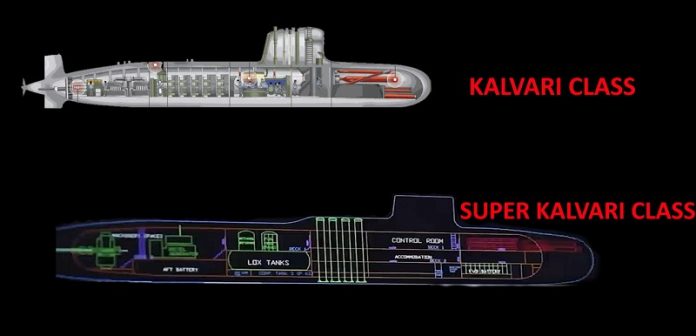Last year, the Indian Navy released a video displaying its capabilities in designing and manufacturing Naval assets and in a split second clip showcased a submarine design that is similar to the present diesel-electric attack Kalvari Class submarine that is based on the Scorpène-class submarine’s design of French and Spanish origin but at a closer look it has two important modular sections that are not part of the Kalvari Class design.
Often called Super Kalvari, diesel-electric attack submarines showcased showed the addition of the Fuel Cell-based Air Independent Propulsion (AIP) System module and addition of 8 missiles in each 4-cell Vertical Launch module that will house BrahMos SLCM or the Nirbhay Sub-sonic cruise missile. In the cutout comparison above even Internals of both the submarines have been redone showing new design changes in the bigger Super Kalvari class that seems to be on the design board.
Kalvari class has an overall length of 66.4m but with the addition of two modules, Super Kalvari will have an estimated overall length of 100m+ that will make it have a submerged displacement of over 3000 tons that will be nearly twice that than the presently submerged displacement of the Kalvari class submarine.
Brazil has used baseline Scorpène-class submarine design and used it to develop a Nuclear attack submarine that will have a submerged displacement of over 8000 tons that confirms that Scorpène-class submarine design is scalable and can be developed into a bigger submarine. France had proposed Scorpène+ class submarine design initially under Indian Navy’s Project-75I but later offered SMX 3.0 concept that has a displacement of 3,000 tons.
Indian Navy will be issuing a Request for Proposal (RFP) for six advanced submarines for the Indian Navy under Project-75I in the next few weeks and it will be interesting to see what kind of submarines vendors will be invited to send their proposals. Coming back to Super Kalvari, the Navy has not confirmed about the program nor has given out details if it will become under Project-75I or Project-76, but recent push to locally develop Lithium-Ion battery system, 5MW Electric Propulsion motor and with successfully trial of the air-independent propulsion (AIP), India is advancing its capabilities to manufacture its own diesel-electric in near future.

